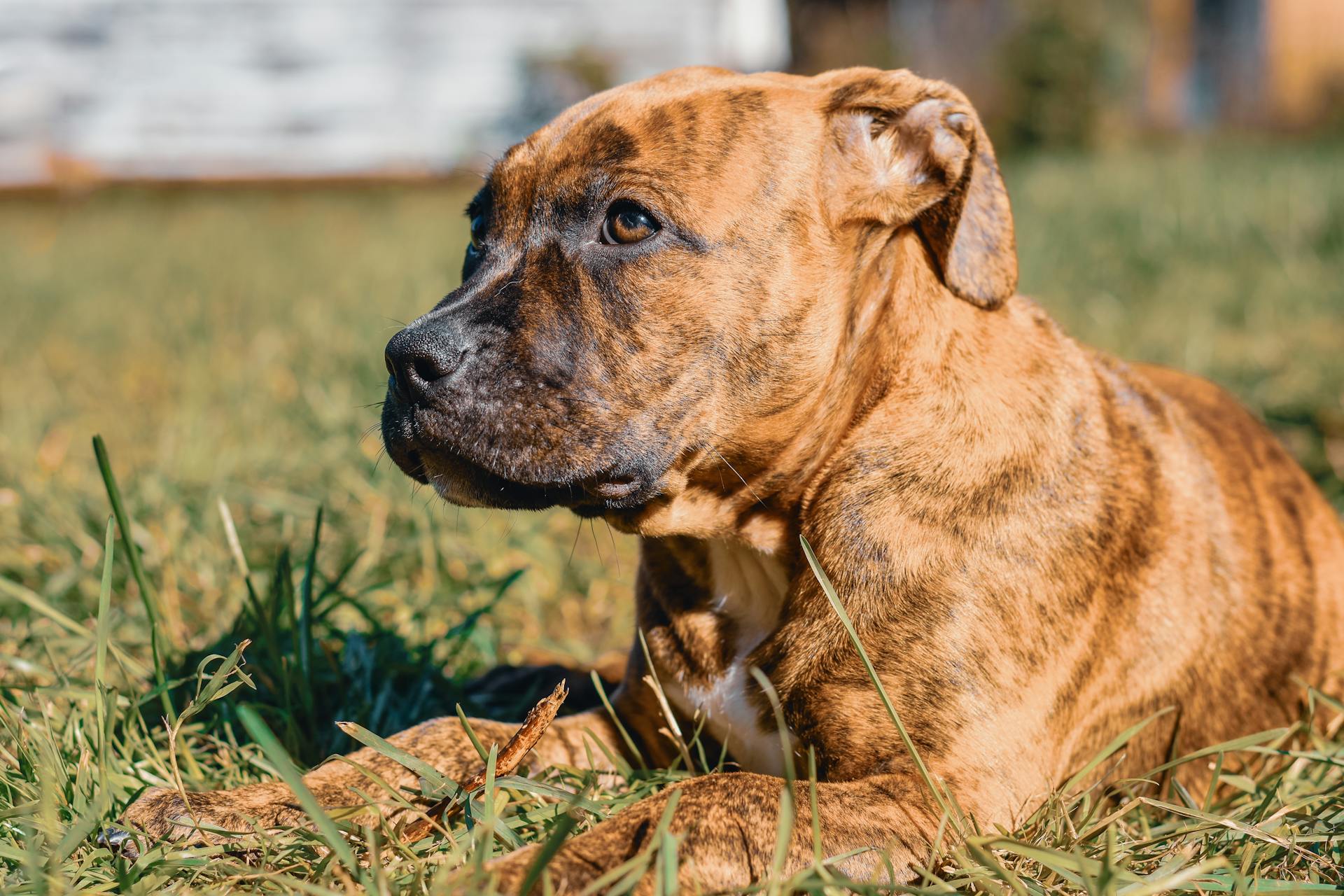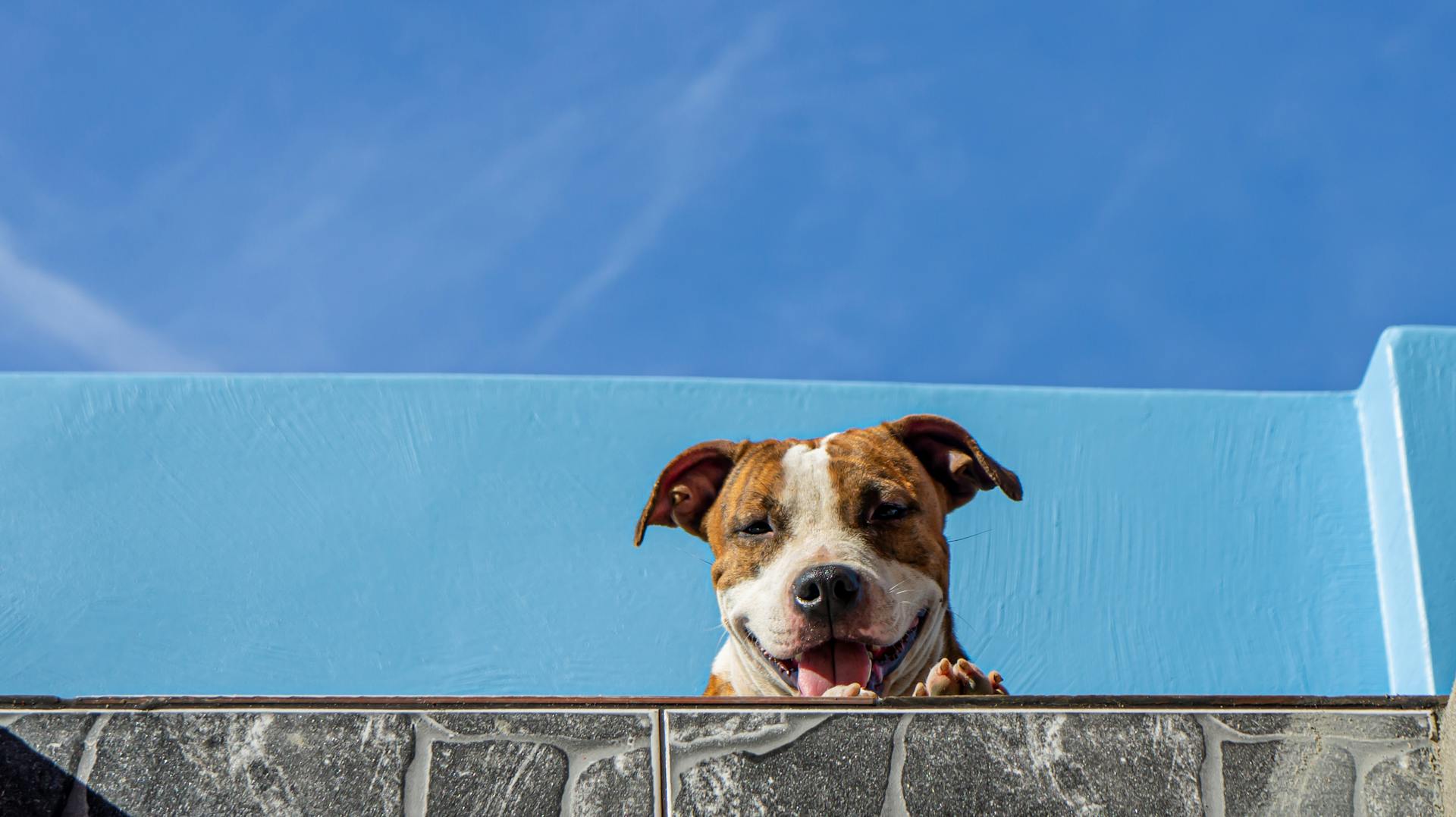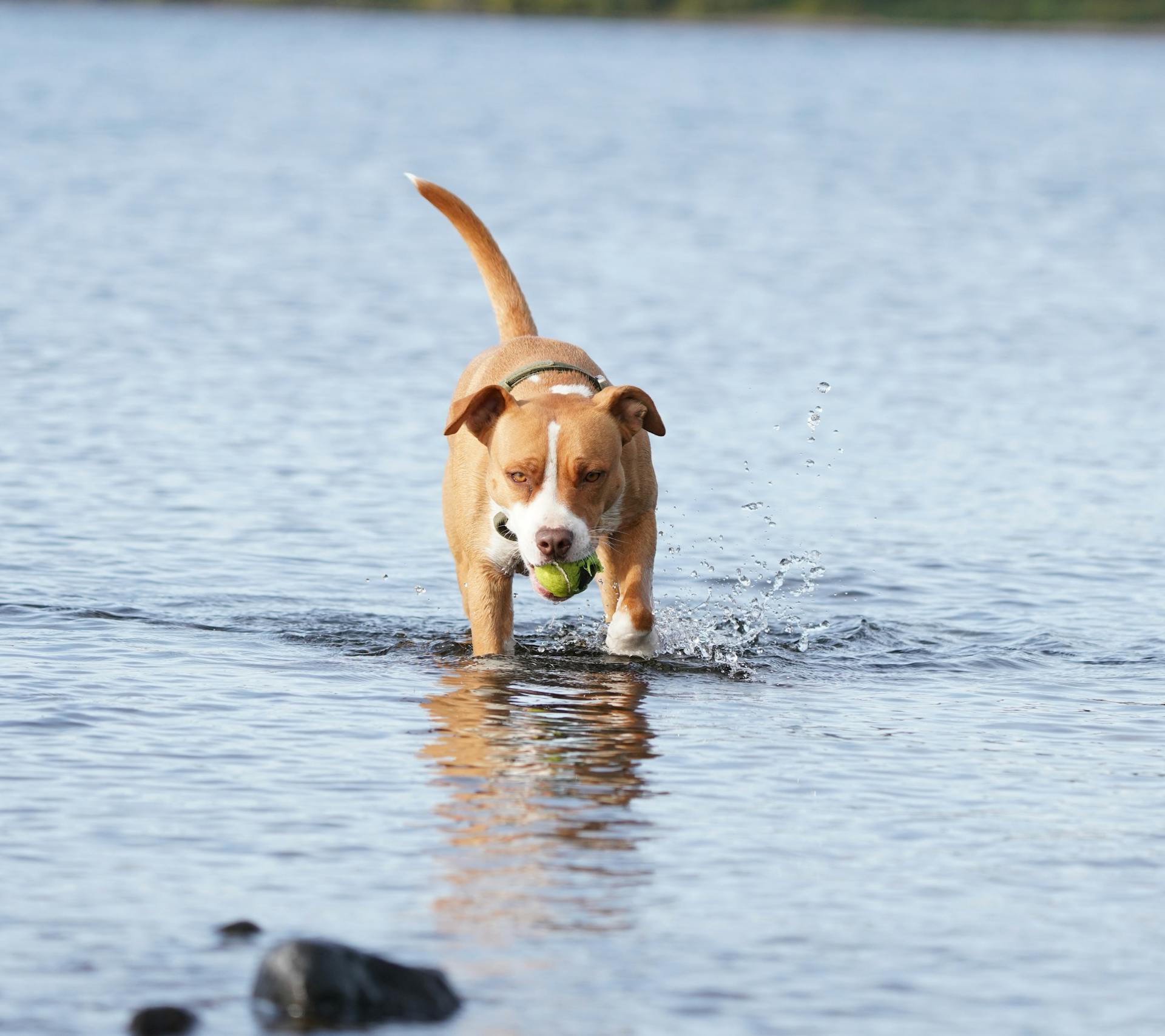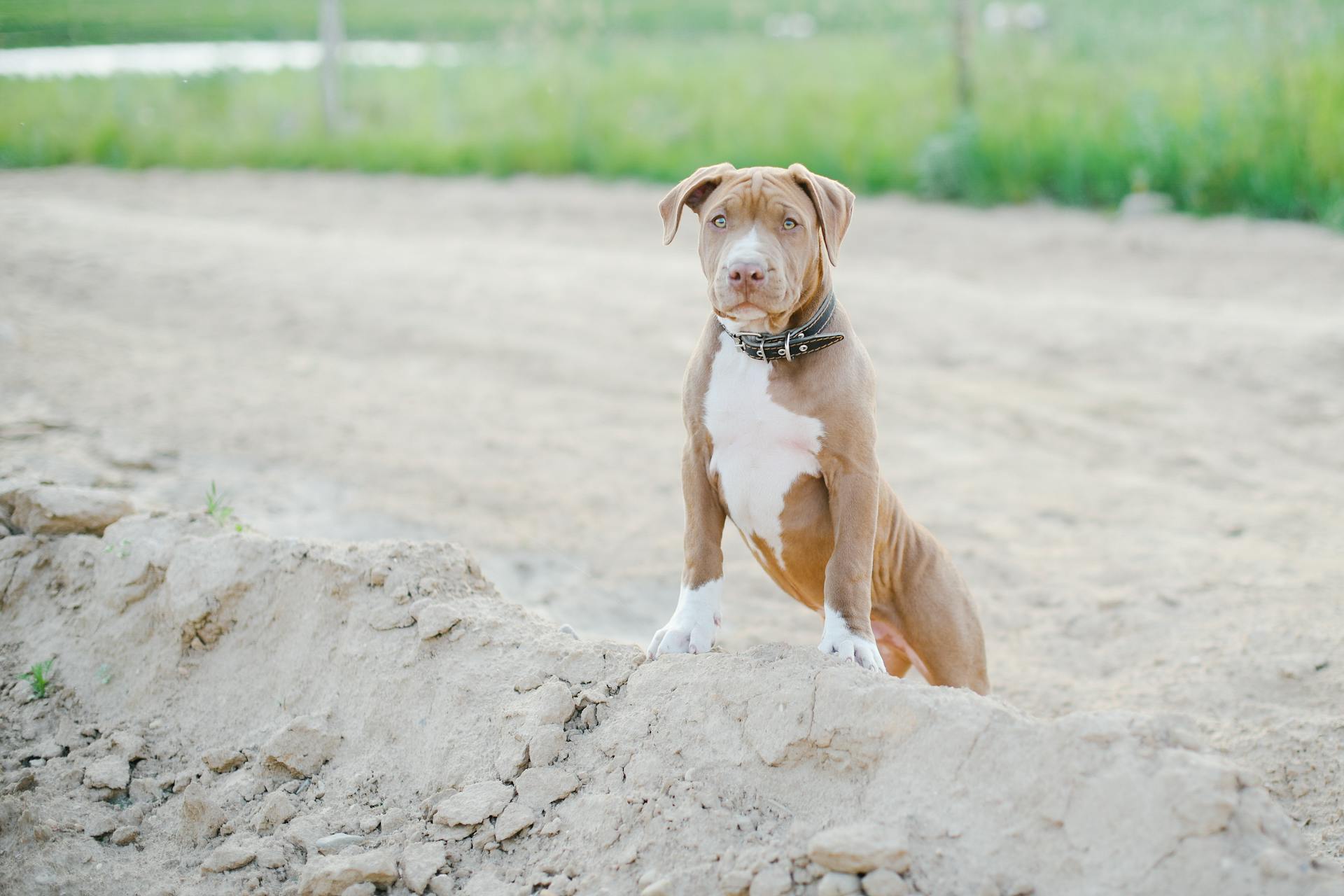
Pitbulls are often misunderstood, but they have a long history as loyal companions and guard dogs.
In fact, they were originally bred to guard livestock and protect families from harm.
Pitbulls are naturally protective of their families, but with proper training, they can be gentle and loving companions.
Their strong instinct to defend their loved ones makes them excellent security dogs.
Here's an interesting read: Pitbulls Good Apartment Dogs
Breed Characteristics
American Pit Bull Terriers have a strong need for attention and training. They can become stubborn and bossy if they don't receive proper socialization and training when they're young.
They're not suitable for owners who can give them little or no attention, as they require consistent training and interaction. If they're not properly trained, they may become hard to handle due to their strength and stubbornness.
American Pit Bull Terriers have a tendency to fight to the finish if they're involved in a dog fight, and they may become aggressive towards other dogs if they're not socialized properly. They should not be let run loose in dog parks, as this can lead to conflicts with other dogs.
Here are some key characteristics of the breed:
- Require consistent training and socialization from an early age
- Need firm, fair training and gentle consistent discipline
- Have a strong need to chew and require durable toys
Highlights
American Pit Bull Terriers are a high-maintenance breed that requires a lot of attention and training. They can be stubborn and bossy, so it's essential to establish clear boundaries and leadership early on.
One thing to keep in mind is that these dogs have a strong prey drive and will not back down from a fight. In dog parks, it's not a good idea to let them run loose, as they may engage with other dogs in a potentially aggressive manner.
If you're considering traveling with your American Pit Bull Terrier, be aware that breed-specific legislation may affect your plans. Research the laws in your area and neighboring regions to avoid any issues.
To keep your American Pit Bull Terrier happy and healthy, provide them with durable toys that can withstand their powerful jaws. They have a strong need to chew, so it's essential to give them the right kind of toys to prevent damage and potential choking hazards.
Explore further: Tough Dog Toys for Pit Bulls
Here are some essential traits to consider when deciding if an American Pit Bull Terrier is the right breed for you:
- High energy level and strong prey drive
- Requires early socialization and training to overcome stubbornness and bossiness
- May be affected by breed-specific legislation
- Needs durable toys to prevent damage and potential choking hazards
Size
When you're considering bringing an American Pit Bull Terrier into your family, one of the first things you might wonder is how big they'll get.
The height of males is typically between 18 to 19 inches.
Females are slightly smaller, with a height range of 17 to 18 inches.
Males can weigh anywhere from 30 to 85 pounds.
Coat Color and Grooming
The American Pit Bull Terrier has a short, shiny coat that's easy to maintain. It comes in a variety of colors including red, blue, brown, grey, black, and white, as well as brindle.
Their coat requires little grooming and can be kept clean with an occasional bath. Brushing with a stiff brush and wiping down with a cloth will help keep their coat shiny.
You should get your Pit Bull Terrier accustomed to being brushed and examined from a young age. Handle their paws frequently, as dogs can be sensitive about their feet.
Make grooming a positive experience by giving them praise and rewards. This will help them feel more comfortable with handling and exams when they're an adult.
Regular grooming sessions can help you spot potential health problems early on. Look for signs of infection like redness, tenderness, or inflammation on their skin, nose, mouth, eyes, and feet.
Health and Care
As a responsible pitbull owner, it's essential to be aware of the potential health issues that can arise in your furry friend. American Pit Bull Terriers are generally healthy, but they can be prone to conditions like hip dysplasia, allergies, hypothyroidism, heart disease, and atopic dermatitis.
A pet insurance plan can help you prepare for any veterinary needs that may arise throughout your dog's life. Regular check-ups with your veterinarian can also help identify any potential issues early on.
To keep your pitbull happy and healthy, be prepared to spend about an hour a day walking, playing with, or exercising them. They're strong for their size and can be stubborn if left to their own devices, so start obedience training early and continue it throughout their life.
Here are some common health issues to look out for in American Pit Bull Terriers:
- Hip Dysplasia (HD)
- Allergies: skin and food-related
- Hypothyroidism: weight gain, poor coat, reproductive problems
- Heart Disease: aortic stenosis, a congenital heart defect
- Atopic dermatitis: a chronic inflammatory skin disease
Health

As a dog owner, it's essential to be aware of the potential health issues that can affect your American Pit Bull Terrier. Hip Dysplasia is a common condition that can cause extreme pain in dogs, so it's crucial to have hip X-rays done at 2 years of age if you plan to breed your dog.
Hip Dysplasia can be extremely painful and may require surgery. Allergies are also quite common in APBTs, and can be caused by environmental allergens like fleas, grass, pollen, and dust, or even certain foods like beef, rice, wheat, and corn.
Dogs with allergies may exhibit intense itching and discomfort, which can lead to secondary infections if not treated properly. Hypothyroidism is another condition that can affect your dog, causing weight gain, poor coat, and reproductive problems.
Hypothyroidism can be controlled with daily medication, but it's essential to continue treatment throughout your dog's life. Heart disease is also a concern, with aortic stenosis being the most common form.

Aortic stenosis is a congenital heart defect that can cause little energy or even sudden death in severe cases. Atopic dermatitis, also known as eczema, is a chronic inflammatory skin disease that affects approximately 10-15% of the canine population.
Here are some common health issues that can affect your American Pit Bull Terrier:
- Hip Dysplasia
- Allergies (environmental and food-related)
- Hypothyroidism
- Heart disease (aortic stenosis)
- Atopic dermatitis (eczema)
Care
American Pit Bull Terriers require regular exercise to stay happy and healthy. Expect to spend about an hour a day walking, playing with, or otherwise exercising this dog.
They can be stubborn if left to their own devices, so it's essential to establish a strong bond through early obedience training and continued practice throughout their life.
American Pit Bull Terriers don't tolerate cold well, so they're best suited as house dogs, even in temperate climates.
Suggestion: Are Pit Bulls and American Bulldogs the Same
Feeding
Feeding your American Pit Bull Terrier is crucial for their overall health and well-being. A highly active dog will need more food than a couch potato dog.

To determine the right amount of food, consider your dog's size, age, build, metabolism, and activity level. The quality of dog food also makes a difference - the better the food, the less you'll need to feed.
Measure your dog's food to prevent overfeeding and obesity. Give meals at set times each day rather than leaving food out all the time. Your dog should have a waist when you look down at them, and you should be able to feel their ribs beneath a layer of muscle but not see them.
If your dog's ribs are buried beneath fat rolls, they need to go on a diet. Brush your dog's teeth at least two or three times a week to remove tartar buildup and bacteria. Daily brushing is even better to prevent gum disease and bad breath.
Check this out: Good Dog Food for Pitbull Bullies
Training and Behavior
American Pit Bull Terriers are naturally confident dogs that thrive on human interaction, making them eager to greet strangers as if they're old friends.
Their love of people can sometimes lead to failure as guard dogs, but their courage is unmatched when it comes to defending their families.
Early socialization is crucial for these dogs, as it helps ensure they grow up to be well-rounded and calm in the presence of new people, sights, and sounds.
Personality
American Pit Bull Terriers are naturally confident and alert dogs, always aware of their surroundings.
Their confidence can sometimes make them seem like natural guard dogs, but in reality, they're more likely to greet strangers enthusiastically than defend against them.
These dogs have a strong desire to be around people and will often try to be lap dogs, despite their size.
Early socialization is crucial for American Pit Bull Terriers, as it helps them grow into well-rounded dogs.
With proper socialization, your puppy will become comfortable around new people, sights, and sounds, making them a joy to be around.
Here's an interesting read: Bully Dog and Pitbull
Trainability
Trainability is a crucial aspect of a dog's behavior, and it's influenced by their breed, age, and individual temperament. Some breeds, like Golden Retrievers, are known for their high trainability.
Dogs can learn new skills and behaviors at any age, but puppies are more receptive to training between 8 and 12 weeks old. This is because their brains are still developing and they're more open to new experiences.
Consistency is key when training a dog. A routine of regular training sessions and clear commands helps them understand what's expected of them. Dogs thrive on predictability and clear communication.
Positive reinforcement techniques, such as treats and praise, are more effective than punishment or negative reinforcement. This approach encourages good behavior and strengthens the bond between dog and owner.
Here's an interesting read: Pitbull Dog Training
Children and Pets
Children and pets can make a wonderful team, but it's essential to remember that no dog should ever be left unsupervised with kids. They should be crated or kenneled when no adult is around to oversee their interactions.
Teach your children to never pull on a dog's ears or tail, and to never approach a dog while it's sleeping or eating. This will help prevent any accidental harm to the dog.
American Pit Bull Terriers, in particular, are known to be great with kids due to their sturdy, energetic, and tolerant nature. They make ideal playmates, but it's still crucial to supervise their interactions.
Some American Pit Bull Terriers may retain a tendency to be aggressive with other dogs due to their dog-fighting heritage. However, early socialization and training can minimize or overcome this aggression, making them dog- and cat-friendly.
History and Rescue
The American Pit Bull Terrier has a rich history that's both fascinating and heartbreaking. This breed was created in early 19th-century England for dog-fighting, but it also developed a reputation as a strong, protective dog known for being gentle and family-friendly.
The breed's genetic makeup includes an unwillingness to bite humans, which made it a popular choice for families. In America, they became all-around farm dogs, hunting wild game, guarding property, and providing companionship.
Today, you can find American Pit Bulls and Pit Bull mixes in shelters across the country, and several dedicated rescue groups are working to find them homes. These groups include Bad Rap, Pit Bull Rescue Central, Pit Bull Project, and Animal Farm Foundation.
If you're considering adopting a Pit Bull, be prepared to address any health issues that may arise, and consider getting a pet insurance plan to keep your dog covered.
Arizona Is Dog Friendly
Arizona is a great place to be a dog lover, thanks to its dog-friendly laws. Arizona is one of the states that no longer bans dogs based on their breeds.
This means that families who own Pitbulls can rest easy knowing their beloved pets are protected. Any dog can attack, and it's not specific to the breed.
Proper training is key to preventing dog bites and attacks, and it's up to the owners to ensure their dogs receive the necessary training. With the right training, even the most "vicious" dog can become a gentle companion.
History
The American Pit Bull Terrier has a rich and complex history that spans centuries. This breed originated in 19th-century England for brutal sports like bull- and bear-baiting.
To make these inhumane sports more tolerable, breeders created dogs with a mix of bull and terrier traits, resulting in a breed that could be aggressive towards other animals but gentle with humans. Bull and terrier breeds were created in early 19th-century England for the popular spectator sports of bull- and bear-baiting.

In the early 19th century, dog-fighting became a popular alternative to bull- and bear-baiting, and the breed's genetic makeup was influenced by this trait. Handlers reaching into the dog-fighting rings wanted to be able to separate dogs without getting hurt themselves.
As a result, the breed developed a reputation as a strong, protective dog known for being gentle and family-friendly. The breed soon developed a reputation as a strong, protective dog known for being gentle and family-friendly.
Immigrants brought these "bulldogs" to America, where they were used as all-around farm dogs, including hunting wild game and guarding property. In keeping with the “bigger is better” mindset of their new country, the settlers developed a dog larger than it had been in England.
In 1898, the UKC, Britain’s equivalent of the AKC, named these bulldogs the American Pit Bull Terrier. The AKC decided to recognize the breed in the early 1930s—but under a new name, the American Staffordshire Terrier.
On a similar theme: Is Pitbull Good Family Dog
Rescue Groups
You can find American Pit Bulls, Pit Bulls, and Pit Bull mixes in just about every shelter in the country. Several good rescue groups are dedicated to finding homes for these much-misunderstood dogs.
Bad Rap, Pit Bull Rescue Central, Pit Bull Project, and Animal Farm Foundation are just a few of the many rescue groups out there.
If you're considering adopting a Pit Bull, make sure you're prepared to address any health issues that may arise after you leave the shelter. A pet insurance plan can keep your dog covered.
Frequently Asked Questions
Can pitbull be used for police dog?
Yes, pitbulls can be used as police dogs due to their strong sense of smell and tracking abilities, making them suitable for scent work, detection, and tracking tasks. Many police agencies across the US are adopting pitbulls for their canine units through grant programs.
Is Pitbull a safe dog?
Yes, well-managed and responsibly owned Pitbulls can make safe and loving family dogs, with a stable temperament according to the American Canine Temperament Test Society.
Featured Images: pexels.com


